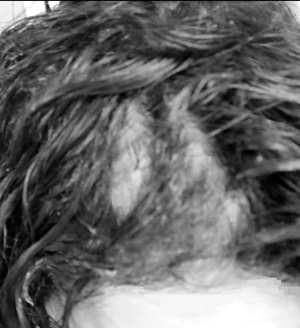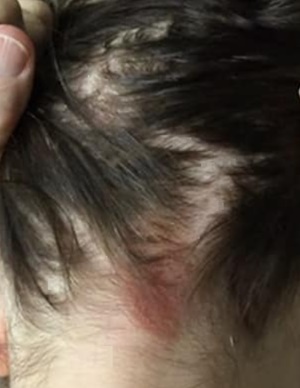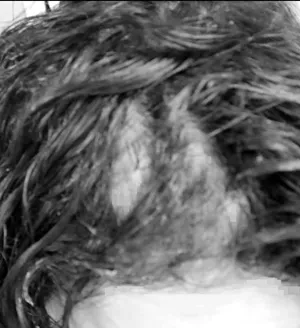
How Do You Fight Women's Hair Loss And Win?
 Hairloss Along Hairline Edges - Hair Loss SBHB
Hairloss Along Hairline Edges - Hair Loss SBHBAccording to the American Hair Loss Association (AHLA), forty percent of American hair loss sufferers are women. Some hair loss experts place the number of female hair loss suffers around 40 or 50 million.
After menopause, two-thirds of women experience hair thinning or bald spots on their heads.
AHLA founder and hair loss consumer advocate Spencer David Kobren believes hair loss in women is devastating.
Women suffering from hair loss experience a loss of self-esteem. When women lose their hair, it impacts their entire emotional well-being.
Women's Hair Loss Awareness Is Slowly Expanding
 Hairloss Around The Hairline - SBHB
Hairloss Around The Hairline - SBHBAwareness about women's hair loss is more prominent in 2022 due to celebrity revelations. Unfortunately, it's still considered to be a silent epidemic.
The reality? Women's hair loss is undertreated, underreported, and gets no respect from society, family members, and even physicians.
During my own lifelong struggle with periods of hair loss, I've constantly researched women's hair loss.
I've discovered there are four major steps women can take to successfully overcome their hair loss battle.
Four Major Steps Women Can Take To Win Their Hair Loss Fight
The following four key hair loss steps can empower any woman with hair loss to win their own battle.
While some forms of women's progressive hair loss are not reversible, most can be stalled or even stopped for an extended period of time.
 Female Hair Loss
Female Hair LossListed below are the four key hair loss steps any woman struggling with this condition should consider embracing:
Knowledge
IdentificationTesting/Diagnosis
Start TreatmentKnowledge
Prevention is one of the most powerful steps in a woman's hair loss journey. The most common type of hair loss is genetically predetermined.Androgenic alopecia (AGA) impacts both men and women. AGA can be passed down from either side of the family tree. All young women, even in their teens, need to become well-versed in their family's genetic history of hair loss.
By understanding their lifetime risk factor for AGA, young women can bypass hair loss-triggering practices.
 Hereditary hair loss may become noticeable at any age after puberty. It will worsen and continue to progress over time without treatment.
Hereditary hair loss may become noticeable at any age after puberty. It will worsen and continue to progress over time without treatment.
Wouldn’t it be great if it was possible to know exactly what to expect? It would be great to deal with it if it starts without wasting time, money, and tears of frustration?
These practices might include, but not be limited to:
- Avoiding all use of birth control devices (pills, patches, IUDs, or similar) that may be known to trigger androgenic alopecia.
- Making informed choices for safe birth control without dangerous hormonal additives.
- Skipping uses all toxic chemical hair treatments (bleach, color, relaxing, smoothing, or straightening).
- Avoiding any hairstyling choices (fusion hair extensions, tight braids, weaves, buns, or ponytails) which could trigger traction alopecia.
- Maintaining a nutritionally rich lifestyle with minimal use of alcohol, recreational drugs, or other hair loss-triggering habits.
- Avoiding extreme weight loss shifts, which are known to cause telogen effluvium (TE) shedding.
- Practicing an array of hair-healthy lifestyle habits, including achieving proper hydration, rest, sleep, and exercise.
- Becoming hyper-vigilant for all signs of abnormal hair loss during hormonal shifts (puberty, pregnancy, post-partum, menopause).
- Having a hair loss medical expert as an ongoing resource available if or when you might experience hair loss issues.
Identification
Once you understand your genetic family hair tree and your risk factors for various types of hair loss, it's critical to identify any daily hair changes. Physician - Online Marketing on Unsplash
Physician - Online Marketing on UnsplashIt's critical to know your potential risks and hair loss trigger points. Become totally focused on identifying any hair triggers you experience. That ,way you can immediately take action.
Identification is a psychological process whereby the individual assimilates an aspect, property, or attribute of the other and is transformed wholly or partially by the model that other provides.
Testing And Diagnosis
While it's normal to lose a small amount of hair during everyday life cycles, women at risk for female pattern hair loss (FPHL) need to pay close attention to their shedding.
 Male Lab Technician in 1950
Male Lab Technician in 1950As Dr. Bauman points out, some unaware women may lose 50% of their hair before it’s noticeably visible to the naked eye. The most important step is to measure and assess what’s going on.
Although most female hair loss, especially with AGA, is gradual, other types of hair loss from TE or alopecia areta (AA) may start suddenly. Don't ignore any hair loss symptoms. Whether you have high-risk factors or not, hair loss will not magically disappear.
If and when hair loss seems to exceed a normal daily amount, it's critical to consult a hair loss medical expert. This medical expert might be a dermatologist, hair restoration physician, or endocrinologist.
Getting a very prompt and clear baseline hair loss diagnosis is critical for taking action to slow or stop the progression. When you have a clear diagnosis, you can aggressively pursue cutting-edge and life-changing solutions.
 The types of tests that are available to provide a base hair loss diagnosis include, but are not limited to:
The types of tests that are available to provide a base hair loss diagnosis include, but are not limited to:
- Perform a complete hair history to understand when the hair loss started.
- Do a pull test
- Use sophisticated genetic hair loss testing.
- HairCheck cross-sectional hair bundle trichometer, which measures the quantity and quality of hair on the scalp.
- Examine scalp and hair with a high-powered microscopic examination
- Blood tests to rule out vitamin or nutritional deficiencies, hormone imbalances, infections, or diseases.
- Testing of iron levels. Ferritin, a stored iron, helps to produce hair cell proteins. When deficient, it may trigger hair loss.
- Scalp biopsy. The right ferritin levels maximize the analgenic (growth) phase of hair, encouraging correct length.
Genetic Hair Loss Testing
Some hair restoration physicians, like Alan J. Bauman, MD, in Florida, offer genetic testing for all of his hair loss patients, including women.Dr. Bauman can assess lifetime hair loss risk through sophisticated genetic testing. Lifetime hair loss risks are determined. Those results drive the creation of effective treatment regimens highly.
Not only can patients find out their lifelong hair loss risks, but they can receive highly individualized treatment programs to stall or stop the condition.
Start Treatments
 Once you know you are dealing with any type of hair loss and have a baseline diagnosis begin treatment. The sooner you embark on treatment, the faster the results.
Once you know you are dealing with any type of hair loss and have a baseline diagnosis begin treatment. The sooner you embark on treatment, the faster the results.Non-surgical Options to Treat Hair Loss
Many Hair Restoration Or Regeneration Physicians roll their own unique formulations and treatments. There is a dizzying array of potential hair loss treatments for women.They range from medications to potions, non-surgical injections, microneedling, and various types of massages or mesotherapy.
Hair transplants should always be the last option for women. Historically only 5% of all women are viable hair restoration candidates.
Listed below are some, but not all, potential women's hair loss treatments. Talk to your physician for guidance.
Topical, oral, or a combination of Minoxidil (Rogaine)
Topical, oral, or a combination of Finasteride (Propecia), Dutasteride (Avodart), SpirontonlactoneOral Proscar if you are not in a reproductive cycle.
Compounded Azelaic acid, Minoxidil (vasodilator), and Tretinoin (a form of vitamin A)Stemoxydine (Resveratrol, Serioxyl, Stemoxydine) Serioxyl: Stemoxydine + Resveratrol
CNPDA (caffeine, niacinamide panthenol, and dimethicone)Cortisone Injections, especially for Alopecia Areata
Chemotherapy cooling caps triggered by chemotherapyPRP Hair Therapy
TransEpidermal Delivery (TED) utilizing sound waves and air pressurePRP with ACell, ATP, Hyptothermosol, or Glytone Fertilizers

HypoThermosol
PRP with PDOgro™PDOgro™ as a standalone treatment
Exome InjectionsMesotherapy
Collagen InductionTherapy Low-Level Laser Therapy (LLLT)
Fractionated laser treatmentsMicroneedling
MassageNutrition
Supplementsquercetin
Antifungal treatmentsKetoconazole
Nizoral3-D Printed hair and scalp cranial prosthetic replacement system
 Scalp Micropigmentation
Scalp MicropigmentationTricopigmentation (temporary SMP).
Toppers, wigs, or hair systemsHair coverups. fibers or paint
Accessories such as beanies, caps, hats, scarves, or similarHair Transplant
Hair transplantation would not be the first solution for women.The type of hair restoration surgeries available for women include, but are not limited to:
1-FUT
2- FUE by a micromotor3-FUE manual
4-FUE without shaving5-DIRECT HAIR IMPLANTATION (DHI)
6-Body Hair TransplantationSummary - How Do You Fight Women's Hair Loss And Win?
For some women, the temptation is silently living with their hair loss. Acceptance is hard, but they try their best.Others will fight to the bitter end.
Even if it means maxing out credit cards on risky female hair loss remedies.
Sadly, most of those only lead to more frustration and disappointment. In the hair loss industry, most promises are hollow.
Women struggling with hair loss may be frantic. They just want to fix the problem. They allow themselves to be tempted by quick fixes or false guarantees.
Follow the steps listed: knowledge, identification, testing, and starting treatment to fight women's hair loss and win.
Note: I am not a medical doctor or physician. Always consult with your physician of choice.Social Media Network Information
Please follow us on Twitter at: https://Twitter.com/HairBoutique. I look forward to meeting new people from all walks of Twitter and learning from their Tweets.
















